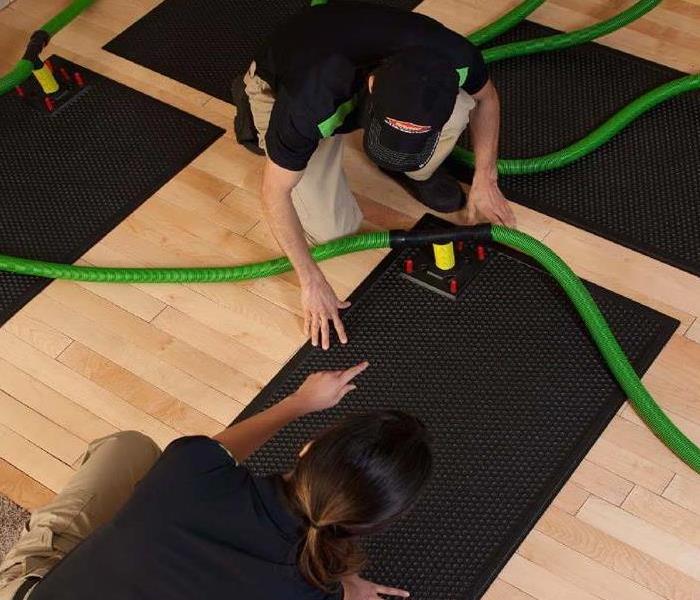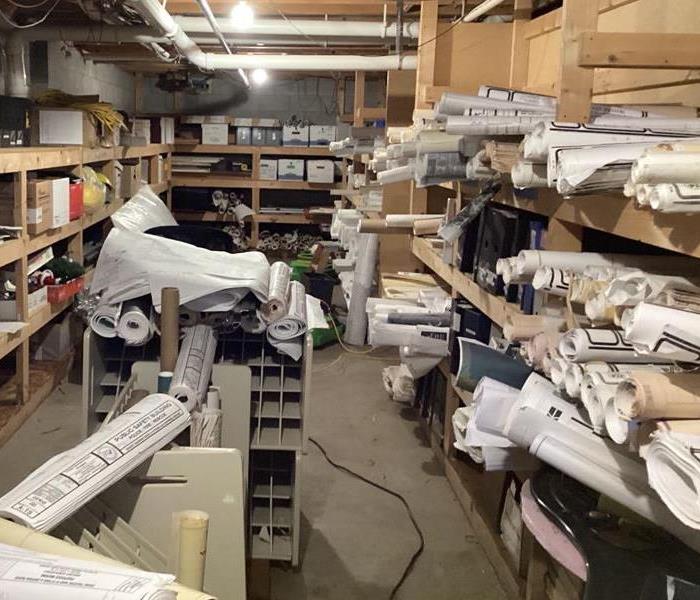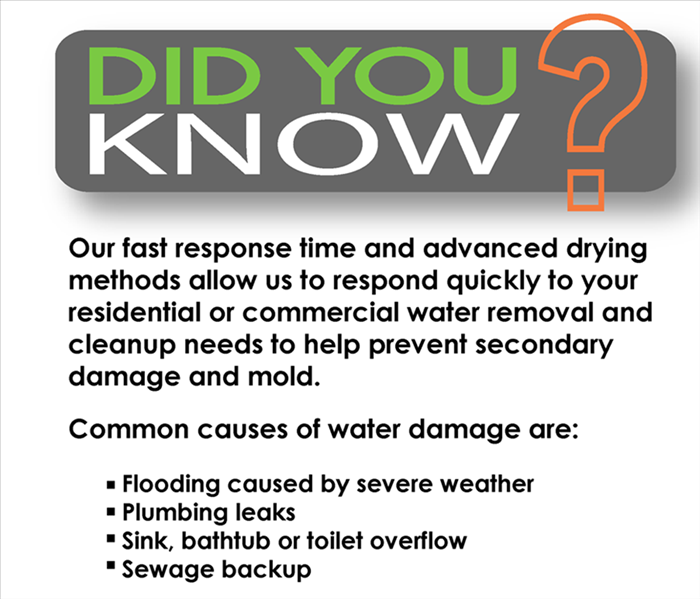Archived Water Damage Blog Posts
Wood floors in water damages
9/12/2024 (Permalink)
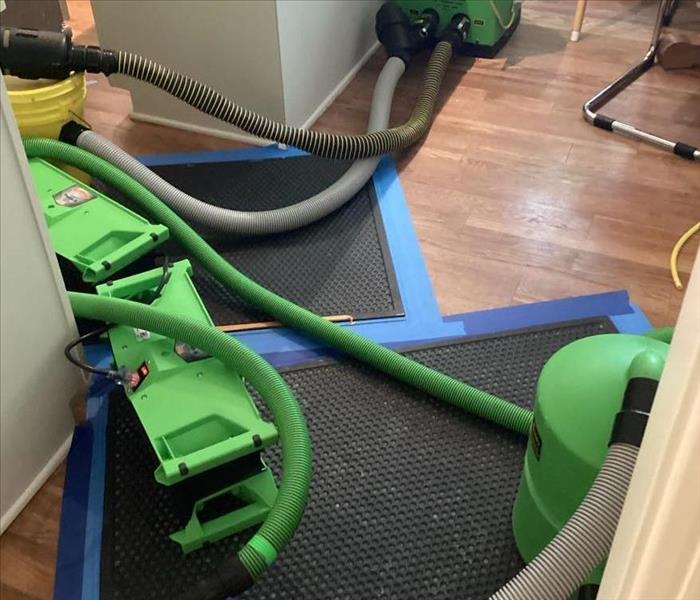 Wood floor drying system
Wood floor drying system
There is never a good time for water damage in your home or business. But it's important that water damage is handled immediately to prevent further damage.
SERVPRO has specialized equipment to help dry your home. One piece of equipment we use is a wood floor drying system that helps save wood floors from having to be replaced. By utilizing this equipment we are able to extract the water from the wood floor and dry the floor without having to remove any of the floor. This helps our customers get back to normal without having the hassle of having cabinets and flooring removed.
If you experience water damage in your home and business, give us a call and we'll respond with the best equipment to get you back to normal.
Science of Drying
8/18/2023 (Permalink)
Did you know there is actually a science behind the process of drying? Having the knowledge of psychrometrics is essential to restoring a water-damaged structure to its preloss condition. While your initial reaction may be to grab a few towels to mop up the mess and place a fan or two around the damaged area, SERVPRO is trained in the science of drying and follow strict industry-approved standards to help lower the chances of any secondary damages. If your home or business suffers a water damage, your local SERVPRO team will:
• Inspect the building to detect every component that is wet to help prevent secondary damage from happening.
• Measure how much moisture is in wet materials and monitor whether the materials are drying properly.
• Speed up Mother Nature by using professional drying equipment. What exactly does it mean to help "speed up Mother Nature?"
A wet building can often dry naturally because the environment always seeks equilibrium. When materials are wet, moisture will naturally move to drier air at the surface of the material? but only if the air is, indeed, drier. The only problem is, nature often takes too long and secondary damages may occur while the building is in the process of drying out. SERVPRO has the tools and equipment to help Mother Nature along, including equipment to help dry hardwood floors, tough to reach spaces inside walls, and much more.
SERVPRO also uses state-oft he-art monitoring equipment and a proven scientific process to help speed up the drying of your home or business.
Tips for caring for documents until restoration begins
8/1/2023 (Permalink)
It's important to get damaged documents frozen as soon as possible to help prevent mold and/or further deterioration from occurring. Documents can be frozen at a local cold storage facility or in a home freezer or refrigerator. SERVPRO can send a refrigerated truck to store the documents to help stabilize them on-site until they're ready to ship to our facility.
If possible, gather and take note of all documents that need restoration. This will allow for a smooth pack-out once SERVPRO arrives to assist. Swift action is imperative for document losses. The sooner they are addressed, the higher probability of better quality results.
Understand that some damage is permanent, such as ink runs and ink or mold stains. This type of damage is already deeply embedded into the papers' fibers at the time of loss. Our services do not undo or reverse this type of damage. Once documents have been damaged, they will likely not look brand new again.
It's the water you don't see that causes the most damage
3/22/2021 (Permalink)
Your home should be your place of rest. But when water begins leaking - even small leaks in ares you can't see - your home could quickly become a source of stress. The possibility of harmful mold, rot and unseen damage may affect the value of your home and the health of loves ones.
SERVPRO of Grand Traverse Area understands how disruptive water damages can be for your entire family and will help ensure the water is identified, regardless of where it hides. That's why we offer 24-hour emergency response by trained, uniformed restoration professionals. Our team is trained to safely clean and restore your home, utilizing the following procedures:
- Identify the Source/Type of Water.
- Measure Temperature and Humidity for Drying Analysis.
- Survey the Extent of Damage and Inspect the Premises For Hidden Moisture.
- Perform Emergency Water Extraction.
- Move and Block furniture and Contents.
- Inspect Carpet Pad/Carpet and Provide Service.
- Apply Necessary Treatments (Disinfectants/Deodorization).
- Utilize Advance Drying and Monitoring Equipment.
- Dispose of Refuse
After all, when it comes to your home and your family, even small disasters can feel like huge problems.
So if a water damage occurs in your home, just call SERVPRO of Grand Traverse Area at (231) 943-9750. We are here to help!
It's The Water You Don't See
3/3/2021 (Permalink)
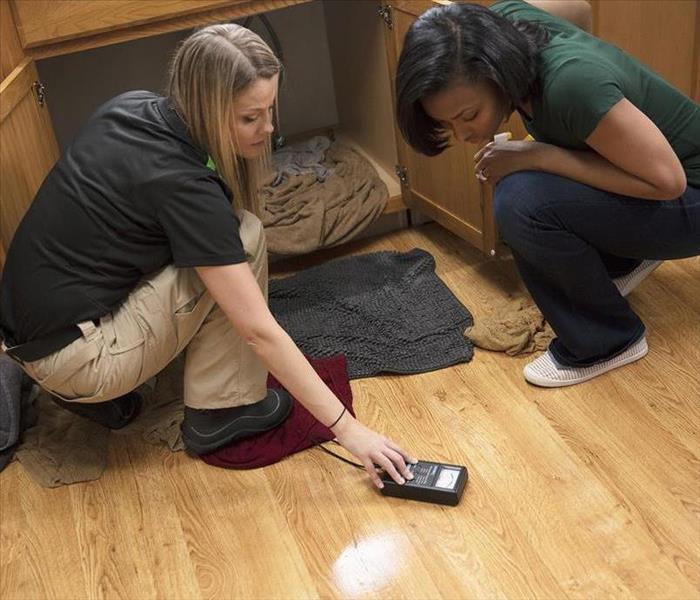 Our SERVPRO technician measuring moisture content on a flooded kitchen floor.
Our SERVPRO technician measuring moisture content on a flooded kitchen floor.
Even small water damages have the potential to cause serious structural and indoor air quality issues over time.
The key to avoiding costly future restoration is to handle every water problem as a real threat to your property. SERVPRO of Grand Traverse Area has the equipment, training, and experience to find and dry unseen water before secondary damages occur. The proper equipment makes a measurable difference in reducing the damage expense during a water loss.
When time matters, technology and equipment must be counted on to perform. SERVPRO of Grand Traverse Area will answer your call with fast action and a full arsenal of drying equipment. Here are a few of the tools we use.
Moisture Meters are used to determine the actual moisture contents of various materials. The moisture tester provides accurate readings, allowing us to monitor the drying process.
Thermohygrometers measure temperature and relative humidity. When armed with this information we can calculate and create an environment most conducive to drying.
Infrared Camera are used to quickly scan large structures for temperature differentials to find the extent of water intrusions.
The bottom line? SERVPRO of Grand Traverse Area has the training and equipment to make it "Like it never even happened."
Understanding Water Types
3/5/2020 (Permalink)
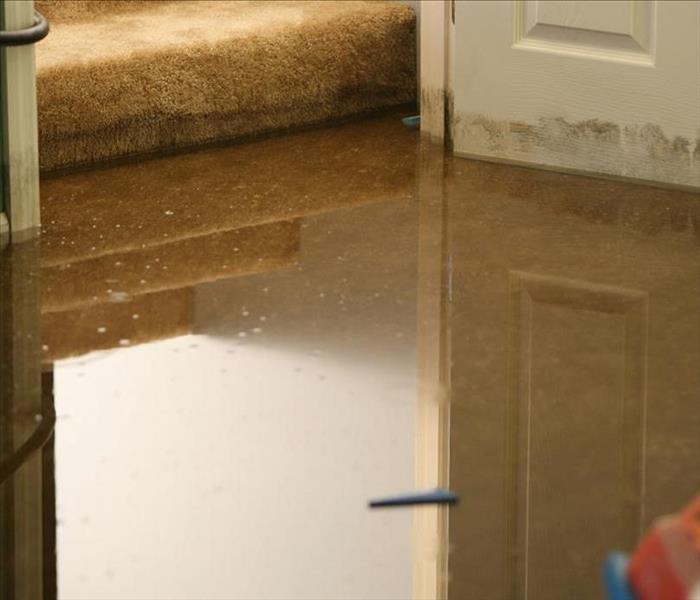 A flooded basement from a pipe break
A flooded basement from a pipe break
When your home or business suffers a water damage, understanding what type of water you are dealing with is critical to ensuring proper cleanup.
There are three types of water. Clean water is water from a broken pipe, or other water source; rainwater is also considered clean. The term gray water is used to classify slightly contaminated water. Clean water becomes gray water when it is left untreated allowing bacteria and other contaminants to begin growing, making the water hazardous. Black water is highly contaminated and filled with fungi, bacteria, chemicals and more. Black water is typically caused by sewage damage, flooding or any type of natural disaster. Black water should always be handled by trained professionals.
Consider taking the following precautions to help minimize damage or prevent further damage while waiting for help to arrive.
Damage from Clean Water
- Shut off the water source if possible or contact a qualified professional to do so.
- Turn off circuit breakers for wet areas of the building if access to the power distribution panel is safe from potential electrical shock. Do not enter rooms with standing water, as electrical shock hazards may exist.
- Remove as much excess water as possible by mopping and blotting. Wipe excess water from wood furniture after removing lamps and tabletops items.
- Remove and prop up wet upholstery cushions to allow more even drying.
- Move any paintings, are objects, computers, documents and other valuable items that may be sensitive to moisture to a safe place.
- Do not use your household vacuum cleaner to remove water as there is potential for electrical shock or causing damage to the vacuum cleaner.
- Do not turn on ceiling fixtures if ceiling is wet; do not enter rooms where ceilings are sagging from retained water.
Damage from Contaminated Water
- Avoid all contact with sewage and items contaminated by sewage. Wash your hands thoroughly if you come in contact with contaminated items.
- Do not walk through contaminated areas, as you could spread damage to unaffected areas.
- Do not turn on the HVAC system if there is a possibility of spreading contaminated air.
- Do not use household fans to dry the structure; air flow could spread contaminants.
- Discard any food and/or products for personal hygiene and cleanliness if exposed to the contaminated areas.
When you have a water damage, don't leave your property to chance. Call SERVPRO of Grand Traverse Area at (231) 943-9750.
Water Damage in Grand Traverse Area
2/19/2018 (Permalink)
 Flooded home.
Flooded home.
The first 24 hours following a water loss are the most important in preventing secondary or permanent damage. Within four hours of a loss notification, SERVPRO of Grand Traverse Area will be on-site to help ensure a water damage is handled by completing the following steps.
INSPECTION
SERVPRO will inspect affected areas to determine the extent of water damage and will review the inspection with you to answer any questions before beginning any work.
EMERGENCY SERVICES
SERVPRO will take steps to help protect your home or business, as well as personal belongings and other contents, from further damage by extracting the excess water and preparing the area for drying.
MONITORING
To help ensure your home or business and belongings are dried to appropriate industry standards, SERVPRO will monitor the drying process and will communicate the progress with you.
RESTORATION SERVICES
SERVPRO will repair structural materials, reinstall carpets, and clean affected areas of your property. A final walk-through of the jobsite will be conducted with you to help ensure the property was returned to preloss condition.
Ice Dams in Traverse City
1/18/2018 (Permalink)
 An illustration of an ice dam.
An illustration of an ice dam.
Ice dams can be a major problem during the snowy season. They form when heated air melts roof snow downward into water dammed behind still-frozen ice. When the trapped water cannot safely flow or run into the gutter system, it can backflow under the roof's shingles and into the structure's interior areas.
Icicles can be an initial sign of an ice dam, according to Travelers.com. To spot ice dams inside, "check for water stains or moisture in your attic or along the ceiling of exterior walls or your house. Water stains or moisture may be an indication that an ice dam has formed and water has penetrated the roof membrane."
Removing an ice dam as soon as it is found is vital to helping prevent damage to your property and can be done using heated cables, a roof shovel, or calcium chloride ice melter.
Frozen Pipes in Grand Traverse Area
1/4/2018 (Permalink)
 A frozen pipe that has burst.
A frozen pipe that has burst.
Frozen pipes are often those exposed to the cold weather, such as those outside your house, or in cold areas such as basements, attics, garages, or kitchen cabinets.
A burst pipe can cause considerable damage to your property if not addressed quickly. To prevent pipes from freezing, here are a few steps you can take, according to The American Red Cross:
- Be sure to completely drain water from sprinkler lines and outside hoses.
- Open kitchen cabinets to let warm air near the plumbing.
- When the weather is extremely cold, let water drip from faucets that may come from exposed pipes.
- Keep your heat set to the same temperature both day and night.
If frozen pipes occur ion your property causing water damage, SERVPRO of Grand Traverse Area is only a call way, 24/7, ready to restore your property to preloss condition.
Understanding Water Types in Grand Traverse Area
2/28/2017 (Permalink)
 Do you know what type of water this is?
Do you know what type of water this is?
When your home or business suffers a water damage, understanding what type of water you are dealing with is critical to ensuring proper cleanup. There are three types of water. Clean water is water from a broken pipe, or other water source; rainwater is also considered clean. The term gray water is used to classify slightly contaminated water. Clean water becomes gray water when it is left untreated allowing bacteria and other contaminates to begin growing, make the water hazardous. Black water is highly contaminated and filled with fungi, bacteria, chemicals and more. Black water is typically caused by sewage damage, flooding or any type of natural disaster. Black water should always be handled by trained professions. When you have a water damage, don't leave your property to chance. Call SERVPRO of Grand Traverse Area to handle the cleanup.



 24/7 Emergency Service
24/7 Emergency Service

